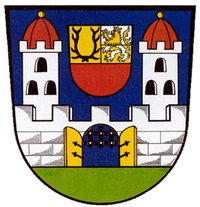Hostun, Gumpert of Hostau founded the town in 1228. Since 1238 the town has been mentioned in documents. Then the town was divided among its successors. Primarily Prothaus was able to unit Hostau successfully again in the sixties of the 14th century. In 1360 the church is mentioned in records for the first time. Not later than 1382 it became a parish, and on March 16,1805 the parish was raised to a deanery. In 1423 Hostau belonged to Tiburz of Wolffstein (Ctibor z Olštejna), which gave Hostau the act of devolution on November 2, 1456 (CIM IV-2, No. 328). On August 7, 1492 (q.v. No. 609) Heinrich of Kolowrat confirms this act. Heinrich was followed by Christian of Guttenstein, who swapped Hostau with Johann of Rabenstein, who likewise confirmed on September 6, 1513 these privileges (CIM IV-3, No. 826). In 1522 Hostau is mentioned as market, which inherited Moritz Schilck of Holitsch in the same year, followed in 1580 by Anna, the wife of George of Guttenstein. On his request Rudolph II. allowed Hostau in 1578 two fairs and a horse market.
On March(?) 11, 1578 Rudolph II gave Hostau the right to red sealing wax for the following crest: In blue on a green sign a castellated wall with open golden gate wings with a black, pulled up gate. Behind the wall are two towers with windows, red domes and golden knobs between a divided split plaque, floats on top at the right side and gold black antlers (derived from the Guttensteiners) on the left side divided in silver and gold is a crowned lion in transposed colors (Rabenstein) on the bottom in red (original lairds of Hostau) (Sedláček 1908, 253). Only this plaque adorns the mayor’s seal, which dated the year 1609 on the upper edge of the sign, and has the following transcription:
SIGILL.IVDICVM.CIVITAIS.HOSTOVI
(Čada 19? NR. 17). Hostau arranged a large and small pair of seals in 1588, a large one in 1609. This had diameter of 1.8 inches, is in silver with the transcription:
SIGILLVUM:CIVITATIS:HOSTOVIENSIS:1.60.9.
It was still used on a ribbon in 1719. It presents the towers with pitched roofs and with five (2, 1, 2) windows each; later three (1, 2) were common (q.v. No. 16, fig. p. II/2). A larger and smaller crest is available from 1806 onward.
